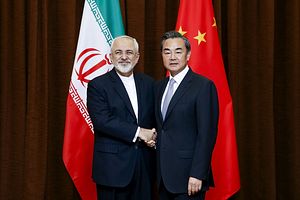The freight train from China that pulled into Tehran a little over a month ago created history by becoming the first train to revive the ancient Silk Route between China and Iran.
Ferrying 32 containers of cargo, it left Yiwu in China’s eastern Zhejiang province on January 2, snaking its way through Kazakhstan and Turkmenistan before entering Iran. It took the train 14 days to cover the roughly 10,399 km long journey to Tehran.
Part of the overland component of China’s One Belt, One Road (OBOR) initiative, the Yiwu-Tehran rail link slashes travel time between China’s east coast and Iran. Its arrival “in less than 14 days is unprecedented,” the head of the Iran Railways company Mohsen Pourseyyed Aqai said. Ferrying cargo via the sea from Shanghai, which lies 300 km north of Yiwu, to the Iranian port of Bandar Abbas takes 45 days in comparison.
The China-Iran “Silk Road train” will run once a month. Its frequency will increase as trade picks up. China’s economic co-operation with Iran, which deepened through the sanctions period – bilateral trade grew from $4 billion in 2003 to $53 billion in 2013 – is expected to soar in the coming years as Beijing and Tehran are eyeing stronger trade ties. In January, during the visit of Chinese President Xi Jinping to Iran, the two sides agreed to increase trade to $600 billion over the coming decade.
The train from Yiwu used existing rail links to run to Iran. China proposes to build new high-speed rail links through Central Asia. Trains carrying Chinese goods will then not terminate at Tehran but run further on to European markets. Besides facilitating Sino-Iran trade, these rail lines will contribute to Iran’s emergence as an important Eurasian trade hub. They will generate income for Iran from transiting trains and integrate it more firmly into the economies of East and Central Asia as well as Europe.
The Yiwu-Tehran train underscores China’s plans for regional integration “with Central Asia as the main hub,” Aryaman Bhatnagar, policy advisor, Peace & Security Programme at Friedrich Ebert Stiftung–India told The Diplomat, drawing attention to China’s significant investment “in both Iran and the Central Asian region for years, especially in the infrastructure sector.”
This investment in internal and trans-border road and rail connectivity has resulted in a massive network that connects China with different parts of Asia and Europe. There is, for instance, the roughly 13,000 km-long railway line – the world’s longest – linking Yiwu with Madrid.
Thus the Yiwu-Tehran railway is “just one of the many projects that enhance regional connectivity, bringing together China, Central Asia, the Persian Gulf and West Asia,” observes Bhatnagar.
Pointing to its significance, he said it is “the most recent example” that proves that China’s OBOR initiative “is not just a ‘pipe dream’ or something that exists only on paper. It confirms that “creating the vast network” that the OBOR envisages “is actually possible with China at the helm.”
Additionally, the Yiwu-Tehran railway lays bare the shortcomings of the narrative on Afghanistan’s possible emergence as trade and transit hub. It shows that regional integration in Central Asia is possible despite instability in Afghanistan and that “China does not need Afghanistan to access the Persian Gulf and beyond,” Bhatnagar pointed out, adding that Beijing “has direct connectivity with Central Asia and can use its existing transport network to fulfill its larger strategic goals.”
Analysts have compared China’s OBOR project through Iran to the one that runs via Pakistan. Unlike the China Pakistan Economic Corridor (CPEC), which runs through Pakistan’s insurgency-wracked Khyber Pakhtunkhwa and Baluchistan provinces, the route via Iran “faces fewer security threats,” argues C Raja Mohan, a noted Indian strategic affairs analyst. What is more, “while building a railway over the Karakorams is a major engineering challenge, China’s Iran corridor only needs to modernize the existing road and rail links between China, Central Asia and Iran.” The Iran route thus has “more chances of success” than the CPEC route to the Arabian Sea, he points out.
Bhatnagar rules out competition between the two routes. The Iran route does not undermine CPEC, he says. The routes “are complimentary in nature and all part of the broader OBOR initiative,” he argued, adding that the projects will “help in creating a broader network of roads, railways and pipelines that would benefit China majorly but the region as a whole as well.”
India will be watching China’s OBOR infrastructure-building in Iran closely. Hitherto, it has responded warily to the OBOR initiative in general, opposing it as a unilateral Chinese initiative that Beijing is pursuing in its own strategic objectives. Indian opponents of the OBOR have described the Maritime Silk Route, for instance, as a “benign-sounding new name for Beijing’s ‘string of pearls’ strategy’” to encircle India.
Rather than reject the OBOR in its entirely or embrace it unquestioningly, some like former Indian Foreign Secretary Shyam Saran suggest a more nuanced approach that involves participation in “those components of the OBOR which may, in fact, improve India’s own connectivity to major markets and resource supplies,” while having “no truck with projects that run against Indian interests.”
Thus India should not participate in CPEC, which runs through Gilgit-Baltistan, over which India has territorial claims. However, it should work with Iran and China to develop Iran’s trade and transport infrastructure. “Instead of seeing Chabahar [port] as an Indian rival to China’s Gwadar project in Pakistan, Delhi should offer to work with Tehran and Beijing to develop Iran’s ports and enhance its road and rail connectivity,” Saran argues.
This would be in India’s interest, as it has been eyeing overland access via Iran to Central Asian markets for some time now. With Tehran poised to emerge as an important transit hub in the Asia-Europe trade, India would gain overland access to Europe as well.
Dr. Sudha Ramachandran is an independent journalist/researcher based in Bangalore, India. She writes on South Asian political and security issues and can be contacted at [email protected].

































